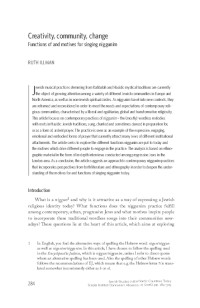Creativity, Community, Change: Functions of and motives for singing niggunim
Author(s)
Publication Name
Publication Date
Abstract
Jewish musical practices stemming from Kabbalah and Hasidic mystical traditions are currently the object of growing attention among a variety of different Jewish communities in Europe and North America, as well as in non-Jewish spiritual circles. This article focuses on contemporary practices of niggunim – the (mostly) wordless melodies with roots in Hasidic Jewish traditions, sung, chanted and sometimes danced in preparation for, or as a form of, ardent prayer. The practice is seen as an example of the expressive, engaging, emotional and embodied forms of prayer that currently attract many Jews of different institutional attachments. As niggunim travel into new contexts, they are reframed and reconsidered in order to meet the needs and expectations of contemporary religious communities, characterised by a liberal and egalitarian, global and transformative religiosity. The article seeks to explore the different functions niggunim are put to today and the motives which drive different people to engage in the practice. The analysis is based on ethno-graphic material in the form of in-depth interviews conducted among progressive Jews in the London area. As a conclusion, the article suggests an approach to contemporary niggunim practices that incorporates perspectives from both literature and ethnography in order to deepen the understanding of the motives for and functions of singing niggunim today
Topics
Genre
Geographic Coverage
Original Language
Volume/Issue
27
Page Number / Article Number
284-305
Link
Bibliographic Information
Creativity, Community, Change: Functions of and motives for singing niggunim. 2016: 284-305. https://archive.jpr.org.uk/object-uk388




